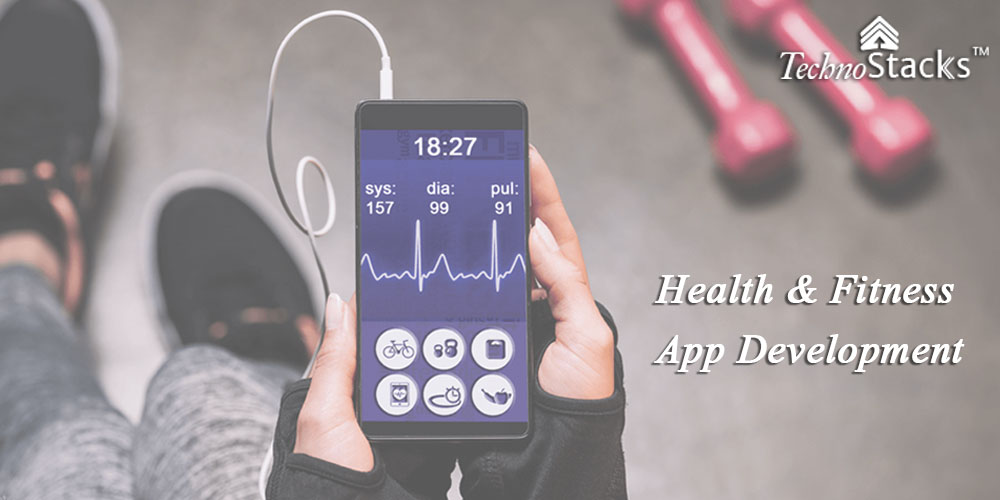How Much Does it Cost to Make a Health & Fitness App?
Health and fitness are primarily the two most used buzzwords of today. People take pledges to stay fit and healthy. They try to sustain with a healthy diet and would take each step to trim down their surplus weight.
Maybe, you are the one who is extremely strong-minded to explore the gym right from the subsequent day, but unfortunately, that day hardly comes into the picture. We accumulate extra calories on a day to day basis and don’t burn them out on a consistent basis. This is where fitness and healthcare app development comes into play to strengthen our workout with diet or nutrition plans.
The number of fitness and healthcare mobile application downloads every year has been progressively rising.
According to netimperative.com, the usage of health and fitness app grew 330% in just 3 years. Many fitness and health app users are dedicated to their preferred mobile apps, with 95 percent to 97 percent sticking and using only one fitness or health app. More than 75 percent of dynamic users open their fitness mobile app at least 2 times a week, and around 25 percent to 30 percent of users accessing their fitness mobile apps 10+ times on a weekly basis.
You can hire mobile app developer resources or can contact the best mobile app development company for fitness and healthcare app development.
Key Features to include when Developing Health and Fitness App
Now it’s time to find out what essential functionalities and features are crucial for any fitness app to survive in the marketplace. We will look at both fundamental as well as advanced features that are precise to all sorts of fitness applications along with the must-have features in health tracking app.
1) Registrations and Creating Accounts
Accounts are vital because they enable users to fill their details and store information. Even users can retain their records if they alter devices. In addition, no business contest is likely without user accounts and their details.
2) Adding Up and Updating Personal Information
The capability to add up and update personal data is significant as the diet or exercise programs in your mobile app must be positioned as per the personal information like the user’s age, height, gender, weight, and other body measurements. Setting and evaluating workouts based on personal information makes the workouts more personalized, and is always acceptable by people who are dealing with health problems.
3) Integrating with other API’s
The most fitting way to register an account in a mobile app is via social media networks. With direct social logins, users can right away see all their data and friends who utilize the same app and can commence publishing their fitness results on their social media accounts. At the outset, this boosts motivation as people can match their progress with their colleagues or friends. Also, it brings more and more users to the application when they observe their friend’s accomplishments.
4) Competing by Setting-up of Targets
Most probably all the fitness applications enable their users to compete by setting up of targets. Some of the apps require having targets for aggressive workouts, while other tracking mobile apps require having targets for the number of daily steps and sleep hours. For diet apps, targets are set on the basis of calorie limits or weight loss. In any of the use case, setting-up of relevant targets is a vital feature for an individual to stay stimulated. Users have to track evidently what they are ruthless for.
5) Why Setting-up of Notifications are Critical
Notifications are critical when it comes to enthusiasm. The most common issue with fitness is losing the interest you had at the commencement. Changes in weather conditions, sluggishness or time issues are just some of the reasons to miss out on decided physical activities or losing your way from a planned diet program. So, a fitness app’s task is to jog your memory on these set plans. Nevertheless, notifications must be modifiable, so they don’t turn irritating. So, letting users set their own type of notifications are required.
6) Settings make your app easy to utilize
Settings are obligatory to make your app tailored and trouble-free to use. However, remember that the settings menu has to be steady and straightforward, yet all-inclusive.
7) Gamification for entertainment and better engagements
Gamification is utilized for entertainment as well as motivation. Engagements by sharing achievements help users to better compete with other adjacent users. It let the users to participate, get rewards, and measure up to the results with their colleagues or friends. Most of the apps today enable users with social media sharing wherein these accomplishments can be shared for increasing engagement levels.
8) Pre-set Work-out and Exercise Scheduling
This feature is explicit to workout mobile apps. This is one of the keys and convenient functionalities for a fitness app as the routines can be precisely tailored.
9) Having a Live Streaming from any Work-out Place
This functionality is new but highly appealing. Live streaming enables users to put on air their daily workouts and check out with expert trainers on the internet while the training procedures conducted at any of the places.
10) Assimilation with Different Wearable Devices and Functions
Your app has to be able to hook up to as many trackers as feasible if you plan to hold up wearable devices and connected functions. You can utilize Google Fit and Apple’s HealthKit for better storage. Additionally, you can utilize diverse wearable APIs powered by Garmin, Jawbone, Tomtom, Withings, and more to attach devices to your mobile app.
11) Tracking and Monitoring of Fitness Activities
Even here Google Fit, as well as, HealthKit will come in better use, as they can unite your application to all the required sensors which include but are not limited to gyroscopes, accelerometers, and compasses. These functionality monitors and tracks daily activities such as walking, running, cycling, and also swimming performances.
12) Geolocation
As activities tracking mobile apps are all about location maps, you should unquestionably put into practice geolocation functionality into your app.
13) Diet Tracking
No diet mobile app can do without food tracking, so you should, without doubt, implement this function. Diet tracking apps have to make it effortless to log data, so the database having a dictionary is required.
14) Barcode Scanner
It assists to turn logging swifter and simpler. With barcode scanning, users can get access to all the required information like calories or constituents by just putting a barcode in the face of their mobile phone.
15) Dashboard
The users will be directed to the dashboard in the mobile app right after they log in. On the dashboard, they can monitor and track the live chat sessions they have had with other stakeholders. The users can check the details of gym equipment or supplements they ordered with their respective delivery dates.
How Much Cost to Develop Health & Fitness App?
The cost and estimated time to develop a fitness app mainly rely on the 3 aspects. Foremost, the intricacy & size of the mobile application, the number of platforms you want your app to sprint on and the location of the app development company. This is because diverse parts of the world have their unlike hourly costs, for example:
- The USA developers: – $60 to $240 charges every hour
- The Europe based developers in the East: – $35 to $155 every hour
- Developers based in India: – $10 to $90 every hour
Below is the fundamental estimate for how much does it cost to develop a fitness app in an ideal use case. The ideal use case talks about an average level mobile app with standard features, developed for Android program with development centre located in India. Let us break down the pricing for all the required activities:
- Cost of technical documentation ranges from $1000 to $2000
- UI/UX design costs between $1400 to $3000
- Back-end and Front-end development costs $10,000 to $ 20,000
- MVP testing sums up to around $3000
- Bug fixing costs approximately accounts around $2000
Approximately, with all costs being added an average fitness app development costs more or less around $17,000 to $30,000 for a single platform. Selecting a cross-platform mobile app and adding together more functionality may elevate the pricing up to $45,000 to $50,000. Nevertheless, investing around $50,000 makes sure your application to stand ahead in the market competition.
Key Takeaways
The demand for health and fitness apps is increasing day by day as it also enables people who don’t go to gyms and it acts as a daily gym instructor for them. However, you have to be highly accurate when you are adding the required functionality and features into your fitness mobile application.
Developing such categories of apps can be a tricky task for the new age developers as on one side they have to draw users through useful features and deliver a flawless experience.
If you are searching for a competent health and fitness application development company, then you have landed at the correct place. We at Technostacks have successfully developed such applications and are the top choice for all types of health as well as fitness app development. You can inquiry us or mail to info@technostacks.com for more information.








